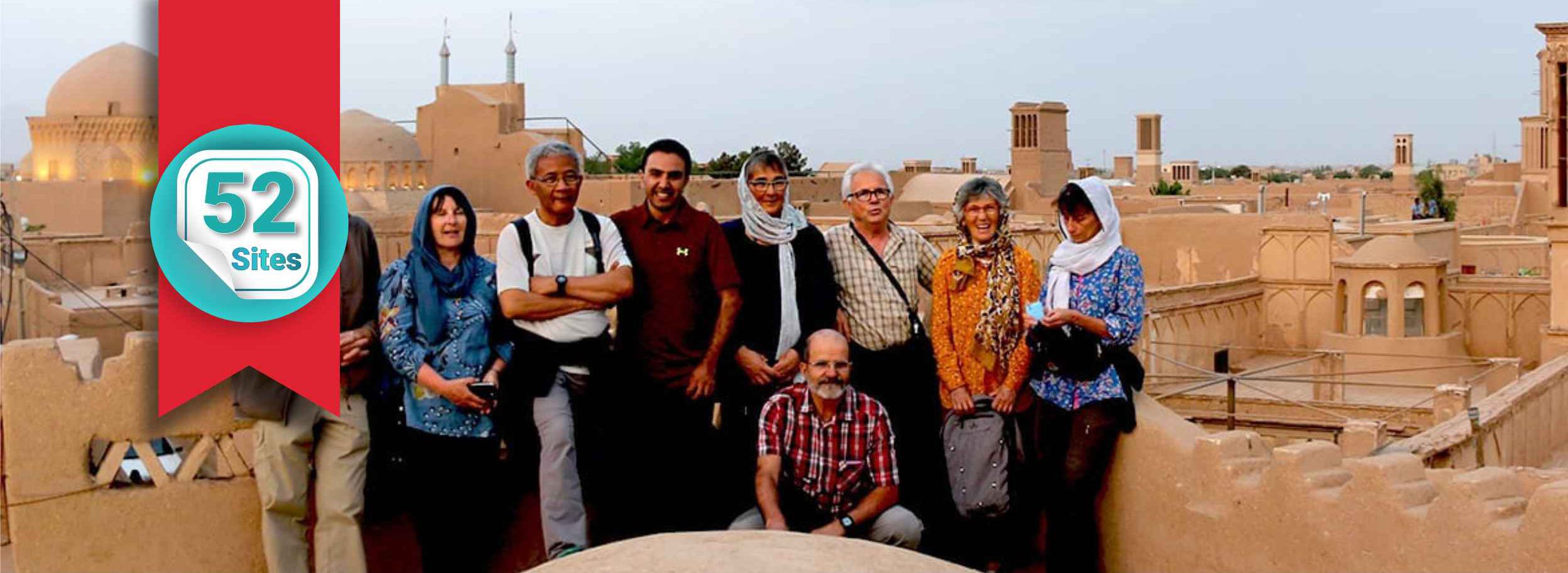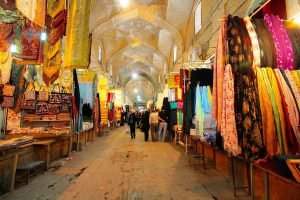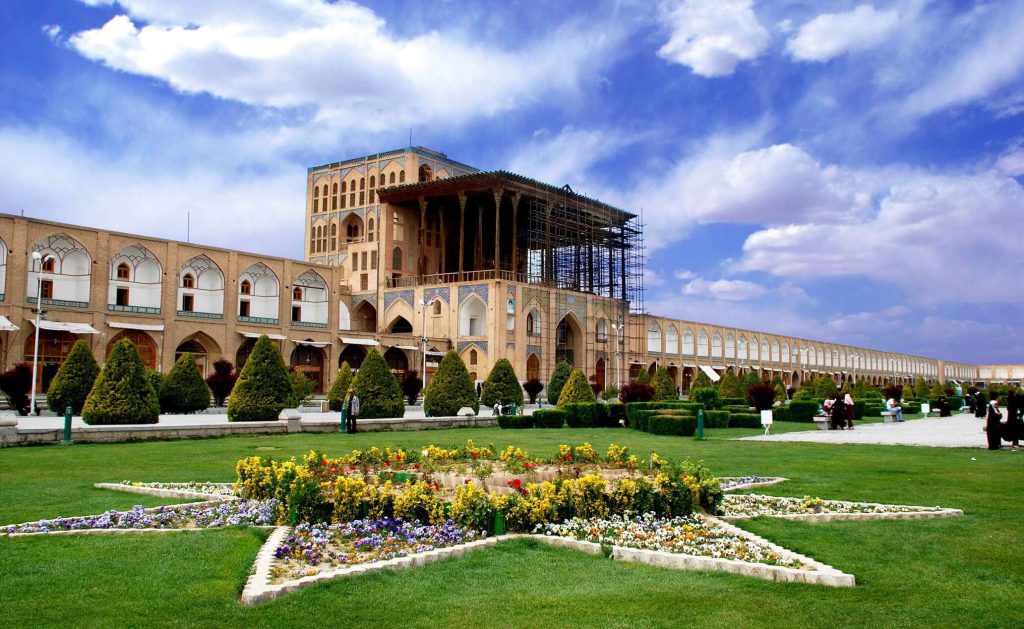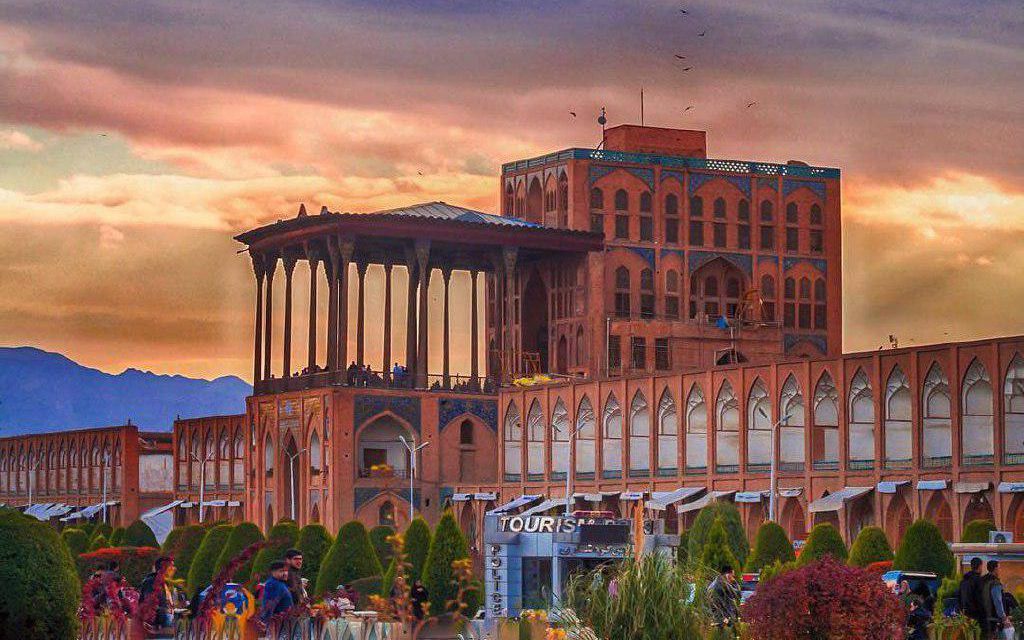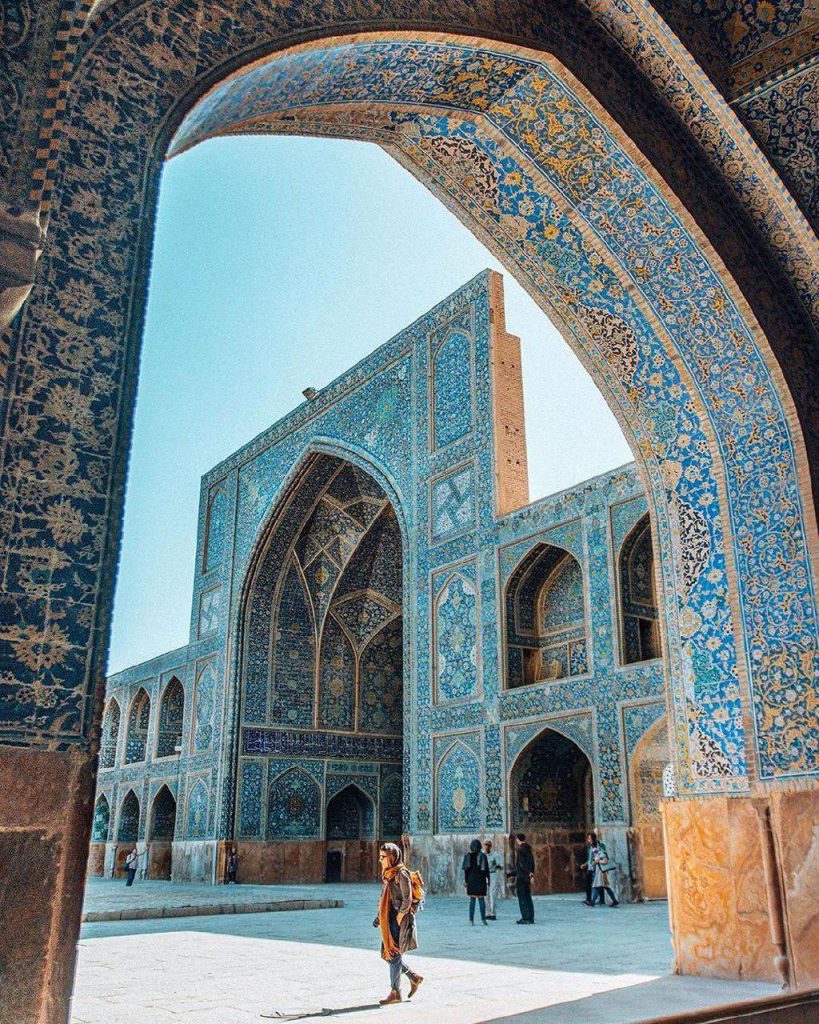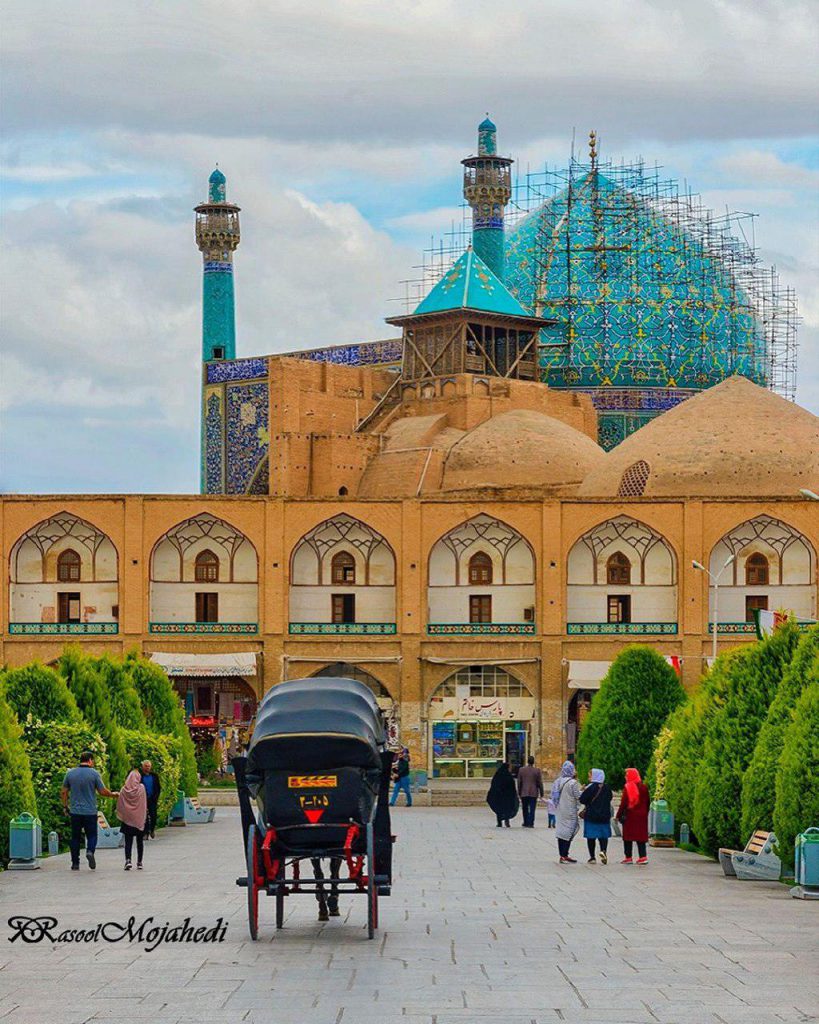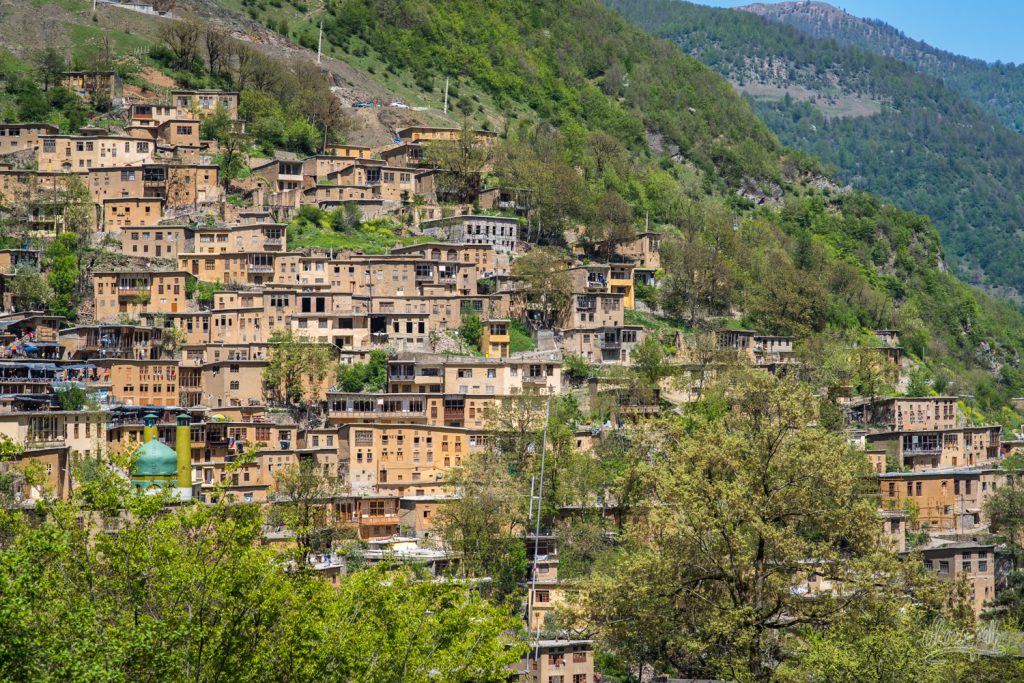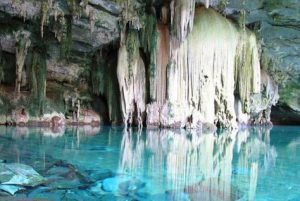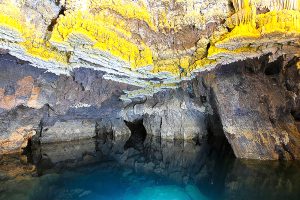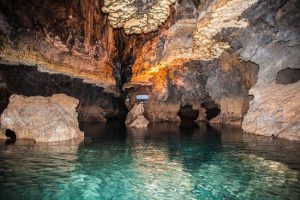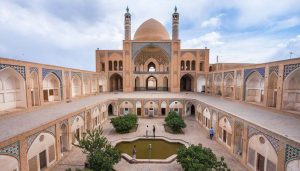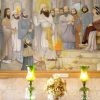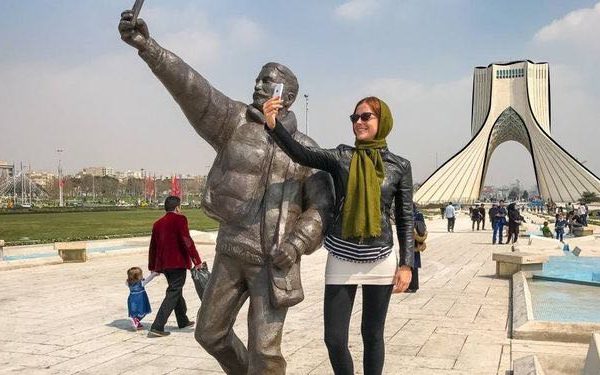Table of Contents
The 52 Iranian Sites
Some months ago, there were threats that Iran would face attacks on 52 sites, “some at a very high level and important to Iran and the Iranian culture.” These threats shook the hearts of many concerned Iranians, always proud of their unique cultural heritages.
As you may know, Iran is a country with one of the oldest civilizations on earth, its history of civilization dating back to at least eight thousand years ago. Hegel, the world-known German philosopher, identified Iranians as the first historical nation and Iran as the first empire in the world. Enjoying such a large and rich history, it is no wonder that Iran hosts some unique cultural heritage sites examples of which can be found nowhere else in the world. Actually, these cultural heritage sites not only do belong to Iranian people but also to human race.
To make my idea clear, let me continue my discussion with some concrete examples. Well, consider the case of Persepolis, the ritual capital of the Achaemenids. Shapur Shahbazi, one the first Iranian archeologists who excavated this world-heritage site, uses an umbrella term to describe the type of art and architecture represented in Persepolis: “the Royal Art.”
“The “Royal Achaemenid Art,” Shahbazi explains, “was the seasoned art of the ancient Near East under new supervision, and that its crown jewel, Persepolis, was the masterpiece of the artistic traditions of the Near Eastern people. Indeed, it would be unfair to regard this monument solely as the heritage of the Persians; It is the heritage of Man.”
As another example, I shall refer to the Atiq Jame Mosque of Isfahan. This ancient jewel may be taken as a concrete history book on Iranian architecture, revealing 14 centuries of Iranian architectural achievement. In each corner of this mosque, an amazing piece of art is waiting to boast its beauty in front of your eyes.
For instance, go to the prayer hall of Oljaito the Mongol and be amazed by its awe-inspiring, delicate plasterwork mihrab: a harmonious amalgamation of arabesque, geometrical and floral designs alongside some holy verses from Koran.
Or just linger for some minutes in the Taj al-Molk dome chamber and breathe in some of the unparalleled beauty in this uncanny place. Your soul would be refreshed after visiting this dome chamber, it is a promise! Besides, it would also be worthy to know how Prof. Arthur Upham Pope, the noted American orientalist, described the Taj al-Molk dome chamber: “This edifice with all its magnificence and glory, along with its mysterious silence, undoubtedly is considered as one of the most beautiful architectural wonders in the world.”
By giving these two examples, I just meant to shed light on the importance of Iran’s cultural heritage sites. But, every corner of Iran is filled with such amazing sites whose other-worldly shapes, designs and beauties contribute to the perfection of our universal spirit.
To raise the world’s consciousness about the hidden beauties in Iran, the members of IranRoute team decided to make short video clips and introduce 52 important Iranian cultural heritage sites to the tourists, visitors and all those who care for Iran and its heritage sites.
So, be with us to watch our weekly video clips of 52 cultural Iranian heritage sites; 52 heritage sites which should survive forever for the sake of humanity.
52 Iranian Heritage Sites the World should never Miss
1.Susa
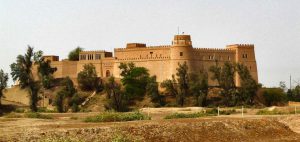 Susa was one of the political, economic and cultural centers of Elam, Anshan and almost the entire Near Eastern world.
Susa was one of the political, economic and cultural centers of Elam, Anshan and almost the entire Near Eastern world.
In this site you can visit:
- Karkheh River
- Dez River
- Karun River
- Apadana
- Acropolis
- Museum of Susa
- Tomb of Daniel
- Palace of Artaxerxes II (Shavur Palace)
2.Pasargadae
 The Pasargadae, located in a 3000-year old windswept plain called Murghab, included a garden divided into four smaller gardens which served as the first example of what later gained fame as the Persian Garden with its Chahar-bagh (fourfold gardens) plan.
The Pasargadae, located in a 3000-year old windswept plain called Murghab, included a garden divided into four smaller gardens which served as the first example of what later gained fame as the Persian Garden with its Chahar-bagh (fourfold gardens) plan.
- The Tomb of Cyrus
- The Mozaffarid Caravanserai
- Cyrus’s Private Palace (Palace P)
- Palace S
- Darvazeh Palace
- Prison of Solomon
- Tall-e Takht
Are located in this site.
3.Behistun Inscription
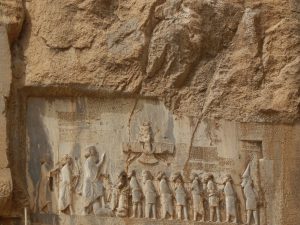 Being the biggest rock wall in Iran, Bisotun Mountain is a part of the Zagros mountain chains. The name Bisotun originates from Bagastana, a Greek word meaning “Place of the god”. Many historical accounts recognize the Bisotun Mountain as the temple for worshipping the ancient gods of Iran.
Being the biggest rock wall in Iran, Bisotun Mountain is a part of the Zagros mountain chains. The name Bisotun originates from Bagastana, a Greek word meaning “Place of the god”. Many historical accounts recognize the Bisotun Mountain as the temple for worshipping the ancient gods of Iran.
You can visit :
- Sarab-e Bisotun
- Paleolithic Caves
- Goudarz’s Bas-relief
- Balash Relief
- Figure of Hercules Relief
- Darius’ Inscriptions and Relief
- Farhad Tarash
- Remains of the Sassanid Palace and Il-Khanid Caravanserai
- Shah Abbasi Bridge
- Abbasi Caravanserai
4.persepolis

persepolis was recognized as a UNESCO World Heritage Site in 1979. In the Islamic era, Persepolis was considered as an honorable place associating Jamshid to the profit Soleiman.
Also in this site You can explore through :
- Grand Stairway
- The Gate of all Lands
- Apadana Palace
- Tachara Palace
- Hadish Palace
- Triplyon Palace (The Central Palace)
- Haramsara Palace
- The Treasury
- Hall of the Hundred Columns
- The Royal Tombs
- The Unfinished Gate
5.Naqsh-e Rustam
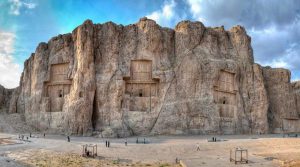 The iconic necropolis of Naqsh-e Rostam is the museum of spectacular reliefs and rock tombs from Elamite to Sassanid periods. Mostly known as the burial place of the Achaemenid kings, it is located about 6 kilometers north west of Persepolis. It comprises four rock tombs of the Achaemenid kings and their families, a cube-shaped building called Ka’beh Zartosht, and seven reliefs from the Sassanid times. Follow the list of attractions in this must-see site near Shiraz (from the east to west side of the cliff).
The iconic necropolis of Naqsh-e Rostam is the museum of spectacular reliefs and rock tombs from Elamite to Sassanid periods. Mostly known as the burial place of the Achaemenid kings, it is located about 6 kilometers north west of Persepolis. It comprises four rock tombs of the Achaemenid kings and their families, a cube-shaped building called Ka’beh Zartosht, and seven reliefs from the Sassanid times. Follow the list of attractions in this must-see site near Shiraz (from the east to west side of the cliff).
6.Ganjnameh
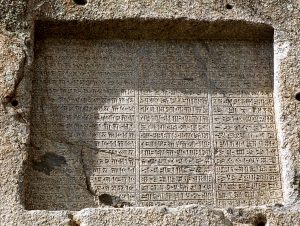 Ganjnameh (Ganjnāmeh), an ancient treasure located five km south-west of Hamadan, sits on the rocky face of Mount Alvand.
Ganjnameh (Ganjnāmeh), an ancient treasure located five km south-west of Hamadan, sits on the rocky face of Mount Alvand.
There are two trilingual Achaemenid inscriptions carved on the body of alvand mountain rock. The inscriptions bear the orders of Darius I and Xerxes. There is a waterfall near the inscriptions.
Some tombs of Kings such as
- Tomb of Xerxes
- Investiture of King Narseh Relief
- Tomb of Darius the Great
- Double Relief of Sassanid Kings, Bahram II and Bahram III
- Relief of King Shapur I
- Tomb of Artaxerxes I
- Relief of King Hormozd II
- Tomb of Darius II
- Relief of king Hormzd I
- Relief of King Bahram II
- Relief of Ardeshir I
and
- Kabe Zartosht (Ka’ba-ye Zartosht)
- The Water Well
are located in this site.
Stay home and watch this interesting video of 52 Iranian sites(Part1):
7.Vakil Complex
Being a UNESCO heritage city, Yazd has housed inhabitants since earlier than the 3rd millennium BC. There are plenty of squares in Yazd surrounded by adjoining buildings such as mosques, bathhouses, cisterns etc.
Arg of Karim Khan (Karim Khan Citadel)
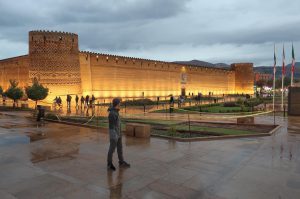 Arg-e Karim Khan is the 18th-century royal castle of the well-known ruler of Zand dynasty, Karim Khan. As Shiraz became the capital of Iran in the Zand era.The Arg is a large, rectangular building, originally surrounded by a 4-meter deep moat as a means of protection against the threats of enemies.
Arg-e Karim Khan is the 18th-century royal castle of the well-known ruler of Zand dynasty, Karim Khan. As Shiraz became the capital of Iran in the Zand era.The Arg is a large, rectangular building, originally surrounded by a 4-meter deep moat as a means of protection against the threats of enemies.
Vakil Mosque
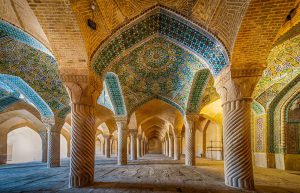
Vakil mosque covers an area of 8,660 square meters and is named after the founder of Zand dynasty. The main entrance is located in the northern side of the mosque, adorned with tiled stalactites, calligraphy and stone friezes. The tile work features the unique Shirazi style of decoration which inspired its subsequent structures in the 18th century. The wooden door is a copy of the Zand era door broken during the Qajar era.
Vakil Bath

Up to 90 years ago, Vakil Bathhouse kept its original function and served people of shiraz as a Hammam or bath. Then, it was turned into a traditional gymnasium, welcoming men to perfom the traditional sport of Iran.
Vakil Bazaar
Vakil bazaar was built between the years 1770 and 1774 following the order of Karim Khan, the regent of Iran and founder of the Zand dynasty. It is said that Karim Khan was inspired by the Safavid Qayṣariya bazaar of Lar, and had this bazaar built in a similar way. This Bazaar was owned by the court which lent the stores to the shopkeepers for a small charge.
8.Amir Chakhmaq Complex
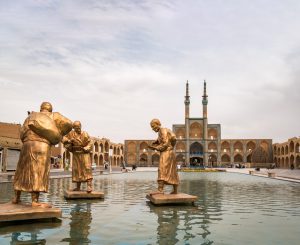
Amir Chakhmaq Square is the most prominent square in the historical city of Yazd ( A UNESCO SITE HERITAGE CITY), built during the Timurid period (15th century).The complex of Amir Chakhmaq (also known as Mir Chakhmaq) is located at the center of the city and is named after its founder, Amir Jalal al-Din Chakhmaq, the Timurid governor of Yazd.
Watch the video of these 52 sites in Iran (part2):
9.Grand Bazaar of Isfahan (Qeysarieh Bazaar)
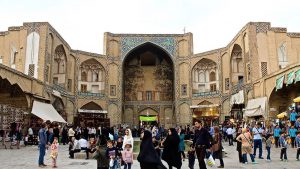 Grand Bazaar of Isfahan or (Qeysarieh Bazaar) is one of the most important, vital parts of the Naqsh-e Jahan Square.This Bazaar, like many other bazaars in Iran, is a roofed structure with high ceilings and corridors with shops aligned on each side. You can enjoy the live gallery of handicrafts and also a number of Safavid, Qajar and Pahlavi constructions, like Saray-e Golshan, Nimavar Theological School, Sadr School and Timcheh Malek.
Grand Bazaar of Isfahan or (Qeysarieh Bazaar) is one of the most important, vital parts of the Naqsh-e Jahan Square.This Bazaar, like many other bazaars in Iran, is a roofed structure with high ceilings and corridors with shops aligned on each side. You can enjoy the live gallery of handicrafts and also a number of Safavid, Qajar and Pahlavi constructions, like Saray-e Golshan, Nimavar Theological School, Sadr School and Timcheh Malek.
- Malek Timcheh (Timcheh Malek)
- Handicrafts of Isfahan
- Carpet
- Enamelwork
- Metal Engraving
10.Naqsh-e-Jahan Square
Meydan-e Naqsh-e Jahan or (Naqsh-e Jahan Square), the second largest square in the world, was one of the earliest constructions which Safavids built to boast their religious, economic and political power in Isfahan. In addition, it provided a vast space for holding public entertainment and national ceremonies. The magnificent turquoise domes and minarets and the vibrant space of the square is what makes it a World Heritage Site, a precious gem whose beauty is unparalleled in the world.
- Sheikh Lotfollah Mosque (Lotfollah Mosque)
- Ali-Qapu Palace
- Qeysarie Gate (Portal)
are located in this site.
11.Ali-Qapu Palace
Ali Qapu Palace is an imperial palace in Isfahan. The main administrative center of the Safavids, in the west of the Naqsh-e Jahan square, is Ali-Qapu palace or the Grand Ālī Qāpū. UNESCO inscribed the Palace and the Square as a World Heritage site due to its cultural and historical importance.
12.Sheikh Lotfollah Mosque
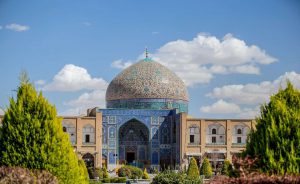
Sheikh Lotfollah Mosque is one of the architectural masterpieces of Iranian architecture, that standing on the eastern side of Naqsh-i Jahan Square, Isfahan. Ali Qapu Palace, located on the west side of the square, was a residence of the Shah(king) and his family, the complex needed a mosque that would be appropriate for the king to pray Sheikh Lotfollah Mosque was the private mosque for the royal family.
13.Jame Abbasi Mosque(Shah Mosque)
Abbasi Jame Mosque (or Abbasi Congregational Mosque) is the main religious pillar of Naqsh-e Jahan Square, located on its southern side. Built upon the order of Shah Abbas the Great, it enjoys a four-porch plan and includes four minarets, three dome-chambres, several mihrabs and two religious schools.
Enjoy your time by watching the video of Iranian cultural sites here (part3):
14.Abyaneh Village
The alluring village of Abyaneh, perched on the slopes of Karkas Mountain Chain, is one of the must-sees in Iran. The name of this village is derived from the word “Viuna”, meaning willow tree.Abyaneh is famous for its unique architecture and specially for the building material used in the construction of its houses, giving the whole village a red tinge.
15.Masuleh Village
Perched on the foothill of the Alborz Mountain Range, Masuleh (Masūleh) is without question one of the most scenic towns in Gilan Province, in the North of Iran.
16.Kandovan Village
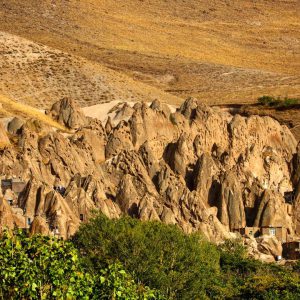
Home is where the heart is. Sometimes it constitutes an urban area, with buildings soaring high in the sky; sometimes it is a mudbrick structure; for some, a tent of leather or cloth is home.Of the three rock villages in the world, only one is residential today, which is called Kandowan. The village is located in the southwest of Tabriz, on the slopes of Sahand Mountain, in Iran. Kandowan means beehive, the appellation owes much to the form of houses dug in conical rock formations; as a result, the entire structure resembles beehives. The village dates back to the 13th century CE; however, this is not to exclude the fact that some sources assume an earlier date for the village’s origination.
17.Palangan Village
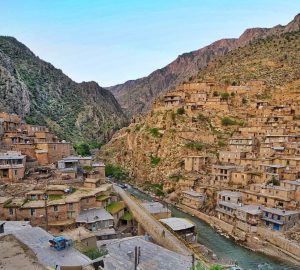 Nestled deep in the slopes of the mountains in Kurdistan Province, there is one such settlement called Palangan (Pālangān). The village is perched on the slopes of the mountains in Tangivar Valley, about 47 kilometers to the northwest of the Kamyaran City. The breathtaking view of this village is enhanced by the Tangivar River, streaming from the middle of the village and dividing it in two.
Nestled deep in the slopes of the mountains in Kurdistan Province, there is one such settlement called Palangan (Pālangān). The village is perched on the slopes of the mountains in Tangivar Valley, about 47 kilometers to the northwest of the Kamyaran City. The breathtaking view of this village is enhanced by the Tangivar River, streaming from the middle of the village and dividing it in two.
Stay home and watch this wonderful video of Iranian heritage sites (part4):
18.Meymand
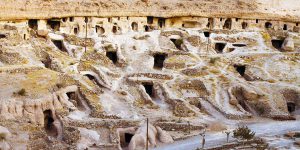 Dating back to 12,000 years ago, the rocky village of Meymand is believed to be a primary human residence in the Iranian Plateau. Meymand Village is located in a relatively arid mountainous area of Kerman Province, its unique structure making it a UNESCO World Heritage Site.
Dating back to 12,000 years ago, the rocky village of Meymand is believed to be a primary human residence in the Iranian Plateau. Meymand Village is located in a relatively arid mountainous area of Kerman Province, its unique structure making it a UNESCO World Heritage Site.
19.Historic City
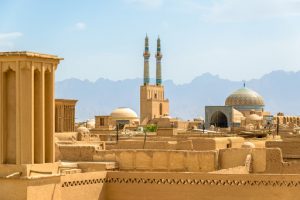 The desert in the central part of Iran is house to a number of settlements, most notably the city of Yazd. Although located in a dry land, the city rose in importance and prosperity as a result of its location on the Silk Road. Nowadays, this city is known as a UNESCO World Heritage Site.
The desert in the central part of Iran is house to a number of settlements, most notably the city of Yazd. Although located in a dry land, the city rose in importance and prosperity as a result of its location on the Silk Road. Nowadays, this city is known as a UNESCO World Heritage Site.
20.Mehriz County
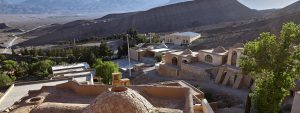 Mehriz County is located on the foot of Mount Shirkooh , some 35 kilometers to the South East of the city of Yazd . The houses have been designed in a way that one side of them has higher walls so that the lodgers can be sheltered under the shadow. Moreover, the houses are usually built some steps lower than the ground to keep the rooms cooler in the summer.
Mehriz County is located on the foot of Mount Shirkooh , some 35 kilometers to the South East of the city of Yazd . The houses have been designed in a way that one side of them has higher walls so that the lodgers can be sheltered under the shadow. Moreover, the houses are usually built some steps lower than the ground to keep the rooms cooler in the summer.
21.Shahr-i Sokhta
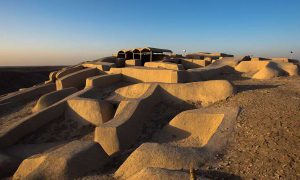 About 56 km from Zabol, the UNESCO World Heritage Site of Shahr-i Sokhta (Shahr-e Sūkhteh) makes a scene for casting new glimpses into the history of human civilization. Shahr-e Sukhteh (literally burnt city) is a remnant of an ancient adobe city. Being located on the trade routes of Bronze Age and enjoying vast cultural and commercial relations with the whole region surrounding it.
About 56 km from Zabol, the UNESCO World Heritage Site of Shahr-i Sokhta (Shahr-e Sūkhteh) makes a scene for casting new glimpses into the history of human civilization. Shahr-e Sukhteh (literally burnt city) is a remnant of an ancient adobe city. Being located on the trade routes of Bronze Age and enjoying vast cultural and commercial relations with the whole region surrounding it.
Get familiar with Iranian cultural and heritage sites by watching these videos (part5):
22.Shushtar Historical Hydraulic System
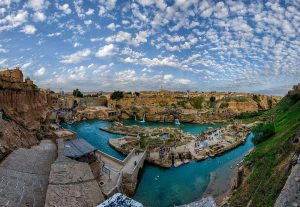 Shushtar (Shūshtar) is an ancient town situated on the southwest of Iran in Khuzestan province. This city is mostly famous for its great hydraulic system, dating back to the Achaemenid era, or more specifically to Darius’s time.It was registered on UNESCO’s list of World Heritage Sites in 2009.
Shushtar (Shūshtar) is an ancient town situated on the southwest of Iran in Khuzestan province. This city is mostly famous for its great hydraulic system, dating back to the Achaemenid era, or more specifically to Darius’s time.It was registered on UNESCO’s list of World Heritage Sites in 2009.
In this wonderfull site you can see:
- Gargar Bridge Dam
- Gargar Canal
- Watermill System
- Band-e Borj-e Ayar (Sabei Kosh)
- Band-e Mahibazan
- The Castle of Salasel
- Dariun Canal
- Band-e-Qeysar
- Band-e Khak
- Band-e Sharabdar
- Band-e Qir
- Kolah Farangi Tower
- Lashkar Dam and Bridge
- Mizan Dam
23.Si-O-Se Pol Bridge
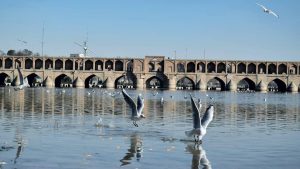 Si-O-Se-Pol (33 bridge) also known as Allahverdi Khan bridge, is the longest historical bridge on Zayanderud. Generally, bridges provide the connection between two separate points as a pass-way, but their story is different in Isfahan. They invite you to stop, contemplate and enjoy the scenery. Each span of the bridge forms a framework of Isfahan, making a live movie of the city when all put together.
Si-O-Se-Pol (33 bridge) also known as Allahverdi Khan bridge, is the longest historical bridge on Zayanderud. Generally, bridges provide the connection between two separate points as a pass-way, but their story is different in Isfahan. They invite you to stop, contemplate and enjoy the scenery. Each span of the bridge forms a framework of Isfahan, making a live movie of the city when all put together.
24.El Goli
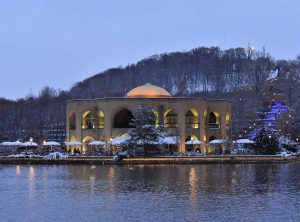 El Goli (El Golu), also known as shah Goli the iconic landmark of Tabriz, is where nature coincides with architecture.The striking feature of this complex is the artificial lake which is assumed to be created in 1785. One of the remarkable features of El Goli is its compatibility with the topographic map of that area in a way that the lake rests on a hillside in the vicinity of the main building. Furthermore, the northwestern side of the hill is composed of different level, forming a staircase-like structure and creating a park with organic spaces on the hillside.
El Goli (El Golu), also known as shah Goli the iconic landmark of Tabriz, is where nature coincides with architecture.The striking feature of this complex is the artificial lake which is assumed to be created in 1785. One of the remarkable features of El Goli is its compatibility with the topographic map of that area in a way that the lake rests on a hillside in the vicinity of the main building. Furthermore, the northwestern side of the hill is composed of different level, forming a staircase-like structure and creating a park with organic spaces on the hillside.
25.Sultan Amir Ahmad Bathhouse
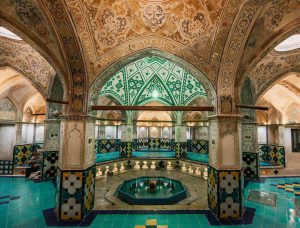 Iranians have had bathhouses for more than 2000 years.Sultan Mir Ahmad historical Bathhouse, an architecturally noticeable building in Kashan, exemplifies a Persian public luxurious bath in an old affluent neighborhood. This Safavid Bathhouse named after Sultan Mir Ahmad Mausoleum, located nearby, is an exhibit of turquoise and gold tiles, plasterwork, and bricks.
Iranians have had bathhouses for more than 2000 years.Sultan Mir Ahmad historical Bathhouse, an architecturally noticeable building in Kashan, exemplifies a Persian public luxurious bath in an old affluent neighborhood. This Safavid Bathhouse named after Sultan Mir Ahmad Mausoleum, located nearby, is an exhibit of turquoise and gold tiles, plasterwork, and bricks.
Watch this video and get familiar with some cultural and heritage sites in Iran (part6):
26.Quran Gate
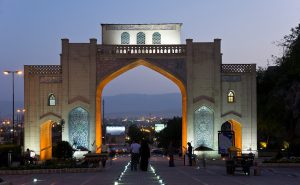 On your way to the Persepolis in northeast Shiraz, close to the city exit to Marvdasht, you can walk under the vault of a huge religious historical gate called Qur’an Gate (Darvazeh-e Quran) . This is one of the oldest and the most prominent gates in its kind, in Iran. Iranians believe if you walk under the holy book Qur’an before traveling, you will have a safe and symbolically blessed trip.
On your way to the Persepolis in northeast Shiraz, close to the city exit to Marvdasht, you can walk under the vault of a huge religious historical gate called Qur’an Gate (Darvazeh-e Quran) . This is one of the oldest and the most prominent gates in its kind, in Iran. Iranians believe if you walk under the holy book Qur’an before traveling, you will have a safe and symbolically blessed trip.
27.Azadi Tower
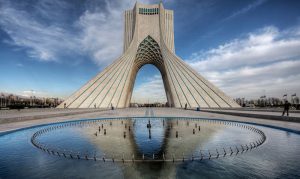 To commemorate the 2500th anniversary of the Persian Empire, Azadi tower (Borj-e Āzādī), still considered as the most important visual icon of Tehran, was built in 1971. In 1966, there was a call for the plan of a monument which could best represent Tehran and Iranian civilization in general. This tower was meant o be a symbol of Modern Iran and, also, a representation of the great ancient civilization of the country.
To commemorate the 2500th anniversary of the Persian Empire, Azadi tower (Borj-e Āzādī), still considered as the most important visual icon of Tehran, was built in 1971. In 1966, there was a call for the plan of a monument which could best represent Tehran and Iranian civilization in general. This tower was meant o be a symbol of Modern Iran and, also, a representation of the great ancient civilization of the country.
28.Milad Tower
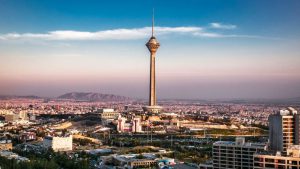 Milad tower is the tallest telecommunication tower in Iran and the 6th tallest one in the world. It took more than 10 years to be built. Visible from most parts of the city, this multi-purpose complex is a landmark of Tehran.
Milad tower is the tallest telecommunication tower in Iran and the 6th tallest one in the world. It took more than 10 years to be built. Visible from most parts of the city, this multi-purpose complex is a landmark of Tehran.
Watch the video below and enjoy these cultural sites in Iran(part7):
29.Alamut Valley
Alamut refers to an isolated valley lying between Siah lan on the north and Alborz and Qazvin mountains on the south. based on more concrete historical evidence, this fortress was part of the Buyid territory and it is said that it was constructed by one of the Daylamite kings in 860.

30.Ali-Sadr Cave
The UNESCO tentative listed Ali Sadr Cave as a world natural heritage. This outstanding cave system, discovered by a group of mountaineers in 1963, grants you access to the longest subterranean water caves in the world. Formed during the second geological era (about 190 million years ago), this astonishing cave is carved out by various water springs near the cave.
31.Mount Damavand
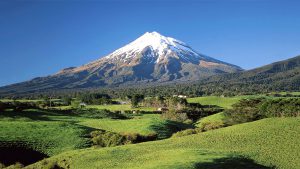 Perched on the central part of Alborz Mt range in the north of Iran, the soaring Mount Damavand and its peak are among the most admired hiking and mountaineering routes for professional mountaineers. mount Damavand includes the highest peak in the Middle East and the loftiest dormant volcano in the Asia.
Perched on the central part of Alborz Mt range in the north of Iran, the soaring Mount Damavand and its peak are among the most admired hiking and mountaineering routes for professional mountaineers. mount Damavand includes the highest peak in the Middle East and the loftiest dormant volcano in the Asia.
Here is the video of these heritage sites (part8):
32.Eram Garden
 Shiraz feels like a heaven on Earth. In this earthly heaven, Eram garden (Bagh- e Eram) occupies an honorable place, which it is enlisted as a UNESCO World Heritage Site. Some sources point out that Eram garden was built in the Seljuq era. However, the current building was erected during the reign of Naser al-din Shah Qajar.
Shiraz feels like a heaven on Earth. In this earthly heaven, Eram garden (Bagh- e Eram) occupies an honorable place, which it is enlisted as a UNESCO World Heritage Site. Some sources point out that Eram garden was built in the Seljuq era. However, the current building was erected during the reign of Naser al-din Shah Qajar.
33.Fin Garden
Persian garden has a history of at least 3000 years. A great number of gardens were built during the Sassanid era and the tradition continued to the Islamic era. Nine Persian gardens in Iran are registered as UNESCO sites,and Fin garden is one of them.
34.National Museum of Iran
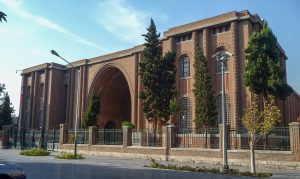 Iran plays an important role in the development of Middle Eastern civilization .This museum present the rich heritage of Iran with a spectacular collection of sculptures, ceramics and seals that date back to the 4th and 5th centuries BC. To get an overall knowledge of the history of Iran, this museum is the best place to visit.
Iran plays an important role in the development of Middle Eastern civilization .This museum present the rich heritage of Iran with a spectacular collection of sculptures, ceramics and seals that date back to the 4th and 5th centuries BC. To get an overall knowledge of the history of Iran, this museum is the best place to visit.
35.National Jewelry Museum
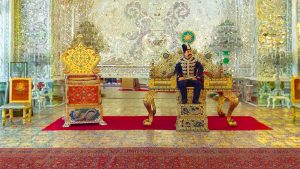 The National Jewelry Treasury is housed within the Central Bank of the Islamic Republic of Iran. The recorded history of the treasury of jewels began with the Safavid monarchs. The unique collection of national jewels mirrors the grand history of Iran, (reminding the visitor of the victories, failures, honors, and dishonors this great country has gone through). National Jewelry Museum of Iran is among the best ten jewelry museums in the world.
The National Jewelry Treasury is housed within the Central Bank of the Islamic Republic of Iran. The recorded history of the treasury of jewels began with the Safavid monarchs. The unique collection of national jewels mirrors the grand history of Iran, (reminding the visitor of the victories, failures, honors, and dishonors this great country has gone through). National Jewelry Museum of Iran is among the best ten jewelry museums in the world.
Here is the video of these heritage sites in Iran, enjoy your time by watching this short clip(Part 9):
36.Agha Bozorg Mosque
Pleasing in its simplicity, this is a five-story mosque with 200 years of history.Construction of the mosque was started in 1834, in Mohammad Shah Qajar’s era, and finished in Naser al-din shah’s era (1848- 1895).
37.Shah Mosque of Tehran
Among the mosques which were built during the Qajar era, a number of them are known as Sultani (royal) mosques or Shah mosques.The Sultani Mosque of Tehran is a four-porch (four ayvans) mosque, located in the Grand Bazaar.
38.Arg e Bam (Bam Citadel)
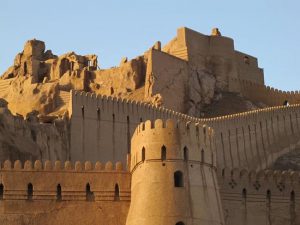
The Citadel of Bam (Arg-e Bam) has claimed the horizon in the outskirts of the city of Bam, in Kerman Province, for more than two millennia.This area was at the crossroads of the Silk Road and roads leading into the Central Asia, the Persian Gulf and Egypt.
To Read more about Iranian Culture:
How Many of UNESCO World Heritage Sites are Located in Iran?


